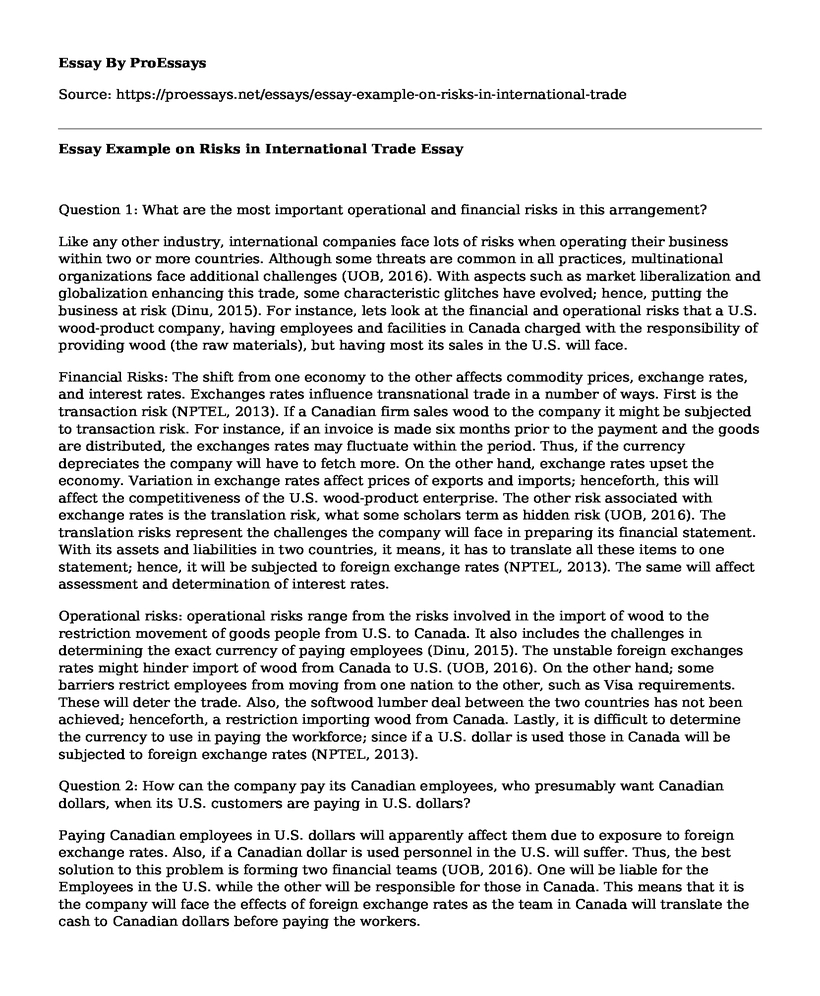Question 1: What are the most important operational and financial risks in this arrangement?
Like any other industry, international companies face lots of risks when operating their business within two or more countries. Although some threats are common in all practices, multinational organizations face additional challenges (UOB, 2016). With aspects such as market liberalization and globalization enhancing this trade, some characteristic glitches have evolved; hence, putting the business at risk (Dinu, 2015). For instance, lets look at the financial and operational risks that a U.S. wood-product company, having employees and facilities in Canada charged with the responsibility of providing wood (the raw materials), but having most its sales in the U.S. will face.
Financial Risks: The shift from one economy to the other affects commodity prices, exchange rates, and interest rates. Exchanges rates influence transnational trade in a number of ways. First is the transaction risk (NPTEL, 2013). If a Canadian firm sales wood to the company it might be subjected to transaction risk. For instance, if an invoice is made six months prior to the payment and the goods are distributed, the exchanges rates may fluctuate within the period. Thus, if the currency depreciates the company will have to fetch more. On the other hand, exchange rates upset the economy. Variation in exchange rates affect prices of exports and imports; henceforth, this will affect the competitiveness of the U.S. wood-product enterprise. The other risk associated with exchange rates is the translation risk, what some scholars term as hidden risk (UOB, 2016). The translation risks represent the challenges the company will face in preparing its financial statement. With its assets and liabilities in two countries, it means, it has to translate all these items to one statement; hence, it will be subjected to foreign exchange rates (NPTEL, 2013). The same will affect assessment and determination of interest rates.
Operational risks: operational risks range from the risks involved in the import of wood to the restriction movement of goods people from U.S. to Canada. It also includes the challenges in determining the exact currency of paying employees (Dinu, 2015). The unstable foreign exchanges rates might hinder import of wood from Canada to U.S. (UOB, 2016). On the other hand; some barriers restrict employees from moving from one nation to the other, such as Visa requirements. These will deter the trade. Also, the softwood lumber deal between the two countries has not been achieved; henceforth, a restriction importing wood from Canada. Lastly, it is difficult to determine the currency to use in paying the workforce; since if a U.S. dollar is used those in Canada will be subjected to foreign exchange rates (NPTEL, 2013).
Question 2: How can the company pay its Canadian employees, who presumably want Canadian dollars, when its U.S. customers are paying in U.S. dollars?
Paying Canadian employees in U.S. dollars will apparently affect them due to exposure to foreign exchange rates. Also, if a Canadian dollar is used personnel in the U.S. will suffer. Thus, the best solution to this problem is forming two financial teams (UOB, 2016). One will be liable for the Employees in the U.S. while the other will be responsible for those in Canada. This means that it is the company will face the effects of foreign exchange rates as the team in Canada will translate the cash to Canadian dollars before paying the workers.
Question 3: How can it calculate its profit if revenue is in U.S. currency and most of its costs are in Canadian currency?
It will be difficult to determine its profit especially due to fluctuations in exchanges rates (Dinu, 2015). However, their presence in both economies will make things light for them. For instance, through observations they can project the trend in exchange rates; thus, calculate their profits. Also, earnings are evaluated at a given time (UOB, 2016). This means by then the exchange rate will be explicit. Hence, it will be easy to work out the returns. Lastly, it could be more effective if the company evaluated its profit in two dimensions that is in Canada and in the U.S. before summing to find the total revenue.
References
Dinu Ana-Maria. (2015). Risk Types in International Trade. Journal of Knowledge Horizons-Economics. Vol 7, No. 1, pp. 92-94. Retrieved on 9 March 2017 from http://orizonturi.ucdc.ro/arhiva/khe7nr1/dinu.pdf.
NPTEL. (2013). International Trade & Risk Associated with International Trade. Module-31 pdf . Retrieved on 9 March 2017 from http://www.nptel.ac.in/courses/110105031/pr_pdf/Module-31%20pdf..pdf.
United Overseas Bank Limited Co. (UOB). (2016) Risks in International Trade and Mitigation Measures. Retrieved on 9 March 2017 from http://www.uob.com.sg/assets/pdfs/corporate/corporate/TradeTutorials_RisksinInternationalTrade.pdf.
Cite this page
Essay Example on Risks in International Trade. (2021, Apr 14). Retrieved from https://proessays.net/essays/essay-example-on-risks-in-international-trade
If you are the original author of this essay and no longer wish to have it published on the ProEssays website, please click below to request its removal:
- Essay Sample on Trade in Iceland
- Retailing and the Change the Business Is Encountering Essay
- Economics of International Trade Essay Example
- Moral Integrity in International Organisations Paper Example
- China-US Trade War: Effects of Tariffs on Economy - Research Paper
- Essay Example on 9/11 WTC Attack: Occupational Hazards & Litigation
- Research Paper on NAFTA: Unlocking Trade Among US, Canada and Mexico







